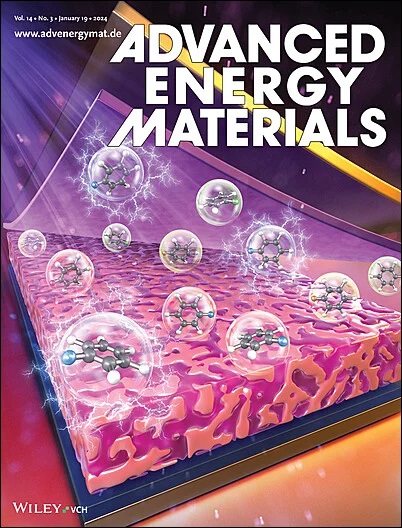Asymmetric Acceptor Featuring Fused‐Imidazole Central Core Enabling Organic Solar Cells with 19.4% Efficiency
IF 24.4
1区 材料科学
Q1 CHEMISTRY, PHYSICAL
引用次数: 0
Abstract
Manipulating the central cores of non‐fullerene acceptors is crucial for enhancing the performance of organic solar cells (OSCs). While recent Y‐acceptors have leveraged a two‐dimensional (2D) π‐expansion strategy to incorporate symmetric fused‐pyrazine central cores, challenges remain in achieving higher device performance. In this study, BTQT‐4F, a novel Y‐acceptor with an asymmetric fused‐imidazole core is introduced. Density functional theory calculations reveal that the asymmetric geometry causes a molecular dipole moment of ≈8.5 Debye. Single‐crystal X‐ray diffraction confirms versatile packing modes that establish efficient 3D charge‐transport channels. Using BTQT‐4F, a power conversion efficiency (PCE) of 18.22% with an open‐circuit voltage (具有熔融咪唑中心核的不对称受体使有机太阳能电池具有19.4%的效率
操纵非富勒烯受体的核心对于提高有机太阳能电池(OSCs)的性能至关重要。虽然最近的Y受体利用二维(2D) π扩展策略来整合对称的熔融吡嗪中心核心,但在实现更高的器件性能方面仍然存在挑战。在这项研究中,BTQT - 4F是一种新的Y受体,具有不对称融合咪唑核。密度泛函理论计算表明,不对称几何结构导致分子偶极矩≈8.5德拜。单晶X射线衍射证实了多功能的包装模式,建立了有效的3D电荷传输通道。利用BTQT‐4F, PM6:BTQT‐4F二元OSCs在开路电压(VOC)为0.890 V的情况下实现了18.22%的功率转换效率(PCE)。值得注意的是,PM6:BTP‐eC9:BTQT‐4F三元OSCs实现了19.4%的PCE,超过了先前报道的基于2D π‐共轭Y‐受体的OSCs效率。这项工作强调了实现不对称融合咪唑核心在推动Y受体设计边界方面的潜力,为进一步提高OSC性能开辟了道路。
本文章由计算机程序翻译,如有差异,请以英文原文为准。
求助全文
约1分钟内获得全文
求助全文
来源期刊

Advanced Energy Materials
CHEMISTRY, PHYSICAL-ENERGY & FUELS
CiteScore
41.90
自引率
4.00%
发文量
889
审稿时长
1.4 months
期刊介绍:
Established in 2011, Advanced Energy Materials is an international, interdisciplinary, English-language journal that focuses on materials used in energy harvesting, conversion, and storage. It is regarded as a top-quality journal alongside Advanced Materials, Advanced Functional Materials, and Small.
With a 2022 Impact Factor of 27.8, Advanced Energy Materials is considered a prime source for the best energy-related research. The journal covers a wide range of topics in energy-related research, including organic and inorganic photovoltaics, batteries and supercapacitors, fuel cells, hydrogen generation and storage, thermoelectrics, water splitting and photocatalysis, solar fuels and thermosolar power, magnetocalorics, and piezoelectronics.
The readership of Advanced Energy Materials includes materials scientists, chemists, physicists, and engineers in both academia and industry. The journal is indexed in various databases and collections, such as Advanced Technologies & Aerospace Database, FIZ Karlsruhe, INSPEC (IET), Science Citation Index Expanded, Technology Collection, and Web of Science, among others.
 求助内容:
求助内容: 应助结果提醒方式:
应助结果提醒方式:


